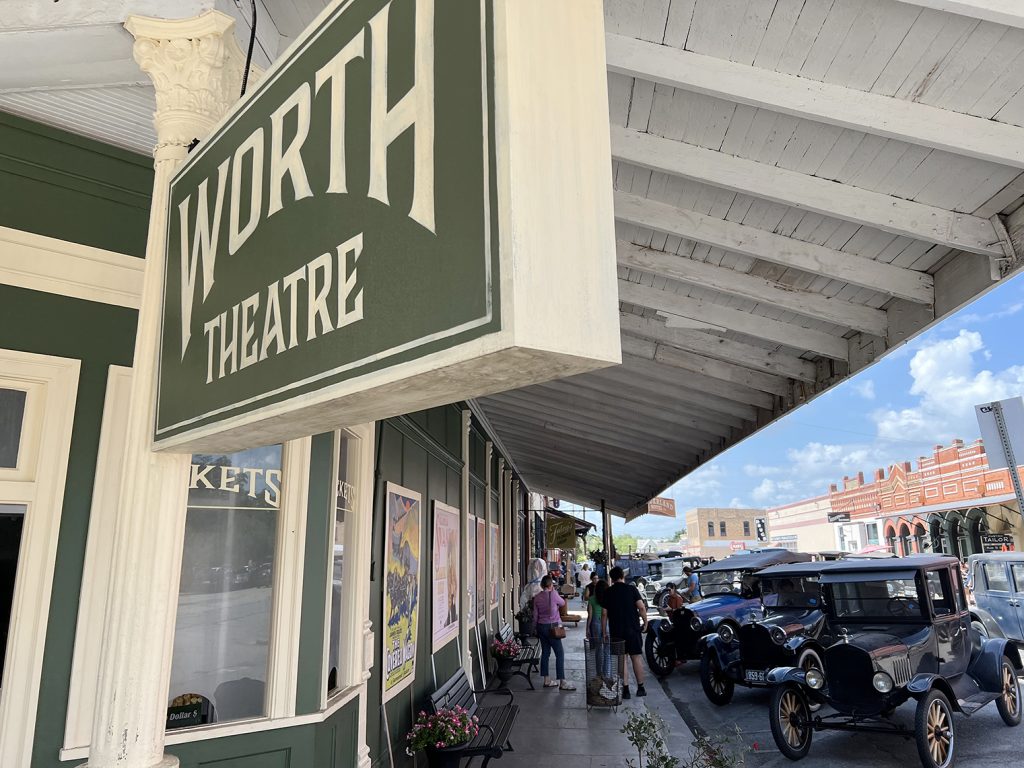Our area’s potential to become a big $tar

Citizens admire the antique cars that were located downtown for the filming of 1923.
LPR stock photo
By Gayle Warren, LPR Contributing Writer
This is the third of a three part series diving into the production industry and the potential the area has to benefit.
Because an estimated 50 percent of a production budget is spent in the location filming area, film making boosts local economies. Film production puts money into circulation as professionals, local talent, properties, sound stages, rentals, and facilities are utilized. Lockhart’s strategic location, affordability and small-town charm continue to make it an attractive destination for filmmakers.
There have been events that highlight the area’s ongoing appeal as a film site destination. The “Man vs. Food Barbecue Challenge (2010) was the travel channel’s nod to Lockhart highlighting local barbecue establishments, culminating in a BBQ showdown on the courthouse square.
Another was the Endora Film Fest in November of 2023 that took place in Caldwell County, featuring a special 30th-anniversary screening of “What’s Eating Gilbert Grape.” The festival showcased a mix of new short films, documentaries and creative narratives.
Another example of how comfortable and welcoming film crews and the industry feel became evident while speaking with Richard Platt, a partner in Loop n’ Lil’s Pizza. Although, “1923” was a significant production that transformed this pizza shop into a quaint vintage era furniture store, the alleyway was converted to resemble a prohibition era warehouse. It was an elaborate process that required a lot of people and planning. He related that everyone was well coordinated and managed to be able to make it all operate so smoothly.
Platt related that he and his partners have worked with a wide variety of film companies. He said one of the more recent filmed scenes was a commercial that was shot in their kitchen for the Cheetos brand who is promoting a pizza flavored product. The ad has actors talking about the new Cheeto product with Loop N’ Lil’s pizza oven and work area in the background. The ad which was filmed only a few short weeks ago is now showing in various places.
Platt mused about the production company feeling it worthwhile to travel to Lockhart to film such a brief-seconds-only, national ad and remarked, “that shows how easy Lockhart makes it for the film industry to come here.” He said the production company required the restaurant to be closed for the entire day, even though the actual filming was about two hours. The partners have learned how to negotiate their compensation contracts.
The restaurant, alleyway and the building’s upstairs section have been made available for production scenes including some for HEB, HBO and Wella bar. He said, “I like the HBO productions as they are more lucrative for us. The productions provide fair compensation for potential and actual loss in our business. But just as importantly, there is the economic boost for many in the vicinity because the crew and cast members shop, eat, and drink here and at surrounding places while filming. One production company, filming nearby, ordered and paid for 150 of our pizzas for the cast and crew while filming somewhere else. That was a nice bonus.”
Scenes in the 2019-2020 HEB commercial series featuring several popular team members of the San Antonio Spurs basketball team was filmed here. There were reportedly several sightings of the tall celebrities walking downtown shopping and eating at local businesses.
While it may seem like an easy process of filming, one may not realize the extensive amounts of work permit applications and insurance it takes to get the production in motion. Some may be surprised that it’s not as easy as setting up a camera and saying “Lights, Camera, Action!”
To film a commercial or movie in Lockhart there are important steps to be taken. From permits to permissions, the task could seem daunting to some.
Initially, the city manager’s office is to be contacted to discuss the specifics. It’s imperative that the filming producers or site locators coordinate with city officials to ensure compliance with local ordinances to facilitate a smooth production process.
Whether it’s a commercial or a movie production, the number of permits that may be necessary for filming in the area is extensive. Not all productions require every permit, but some of the most often required permits are base camp, general filming, state or national park filming, Bureau of Land Management, city, or county permits along with private property agreements when crews are using private land. Other permits are road and traffic control, street closure, intermittent traffic control and Department of Transportation (DOT).
With the increased usage of drones there are even permits that need to be filed to use those in production. Special effects & equipment, pyrotechnics and fireworks permits, weapons, prop guns and stunts and safety permits and more come into play when those features are used.
City services often must be involved like the police directing traffic, the street department closing a street section, or the historical preservation commission approving some movement or replacement of signage downtown. It is a large undertaking to film and cities that accommodate the effort.
Lindsey Sully, owner of Go For Locations, a firm specializing in site location for filming, has provided services for producers and crews for more than a decade and said she is familiar with the permit process.
Sully stated, “A large part of my time is spent getting permits for the shoots. The permit process in Lockhart is much easier than in Austin or other places. In Austin the process may take five to seven business days. Sometimes I get the necessary permits in Lockhart in three or so days.” She added, “Lockhart is one of my favorite places to film. It’s charming, the people are friendly and I couldn’t be more grateful for the welcomeness that we receive here.” When asked if she had worked with any notable actors in a commercial, she responded, “Well, some and of course, there’s Matthew McConaughey, I think everyone in the Austin film industry works on set with him at one point or another.”
While researching how a production gets started Lew White, Mayor of Lockhart, said there is not one central city employee to contact to begin the process. But one
individual was named as a go-to person. It turns out, she’s a connector of people, places and things and is definitely not a city employee. She is not paid to do it at all, she simply has a love for Lockhart, and has connections in the film industry. Tamara Carlisle moved here in 2019. Opening an art gallery, she quickly became immersed in the local business and social community.
She had been based in Austin for many years and was a film producer for about 12 years, working all over the country in various aspects of filming, with a lot of commercial and music videos. This allowed her to build a large network of industry. Even though filming had been happening already in this area for years, she saw the potential and spoke with many of her business contacts about coming here because of the diversity of sites with warehouses, historic homes, ranch homes, the State Park, the quaint downtown and so much more.
Carlisle said she contacted 6-8 site locators she knew and expounded on how great the area and possibilities are, and a natural progression began to develop with an uptick in filming here. She has introduced several homeowners to site locators and when those homes or property are used it could mean they can pay a month’s mortgage or more with the compensation they receive for a one-day shoot. It can range from a thousand a day to upwards of six or seven thousand dollars according to the need and demands of the script, the number of crew, the complexity and requirements and various other things.
She said, “As long as the people in Lockhart continue to stay as nice and welcoming as they have, this can only continue to be a win-win for everyone. The film makers will rent the spaces, order food for crew members and visit the shops. They budget to compensate generously and treat owners and properties respectfully. They make things right if something inadvertently happens, like a scratched floor or a latch on a gate is broken. People in films are fun people, and this is a good thing happening for all involved.”
While discussing nationally recognized brands that contracted film crews to film here, Carlisle named some companies like HEB, Keds, Kendra Scott, Rooms-to-Go, Valspar Paint, Tacovas, and most recently an insurance company. She noted that Netflix recently spent several days on film scenes in the 502 building and there is so much more going on.
There is some acknowledgment and recognition from lawmakers that filming in Texas has great potential to be more than what it currently is. To support and attract film production, Texas lawmakers have proposed a significant boost of the current $489 million to the Texas Moving Image Industry Incentive Program (TMIIIP) as part of the 2026-2027 state budget. This proposal includes up to $450 million in grants for TV ads and small films, aiming to make Texas a leading hub for film production. The TMIIIP offers up to 22.5% cash back to qualifying productions. Even so, economists remain skeptical about the return on investment of film incentives, and some state lawmakers say subsidizing movies is not the best use of taxpayer money.
Under the outdated, underserving, 18-year-old program, the state provides rebates to reimburse production companies between 5% and 20% of what they spend in the state, including wages to Texas residents and costs to rent film space or book hotels. At least 60% of the production must be filmed in Texas, according to state law. Productions can receive an additional 2.5% rebate if they film in underutilized or economically distressed areas.
Without a strongly competitive film incentive program, industry experts say, some Texas stories cannot be told in Texas. Taylor Sheridan, who created the massively popular Yellowstone franchise, has lamented to lawmakers that his film “Hell or High Water” was filmed in New Mexico because they offered a 30% rebate. Sheridan is a giant in the film industry, having produced and directed many major film projects and productions. His opinion, words and money can make important things happen.
According to the Texas Film Commission’s official website, Texas offers a range of incentives to attract filmmakers and production companies to the state, primarily through the TMIIIP. This program provides cash grants based on a percentage of a project’s eligible in-state spending, including wages paid to Texas residents. The base incentive rates vary depending on the type of production and the amount spent within Texas. To be eligible, projects must ensure that at least 60% of the total production is completed in Texas, and a minimum of 55% of the paid crew and cast (including extras) are Texas residents.
Beyond state incentives, certain municipalities offer additional local production incentives.
It’s important to note that the Texas Legislature has been considering significant increases to the funding of TMIIIP, with proposals aiming to bolster the state’s competitiveness in the film and television industry.
Creative professionals say the program has been successful — it has created 182,000 Texas jobs and yielded $2.52 billion in-state spending, according to the Texas Film Commission which is housed under the Governor’s office. For every $1 paid out for a grant, $4.69 is spent in the state, Adriana Cruz, executive director of the Texas Economic Development and Tourism division of the governor’s office stated in October 2024.
Texas is one of 37 states to offer a film incentive program. Those programs can take the form of cash grants, as in Texas, or tax credits, which other states offer. Texas still lags Georgia, New Mexico and Louisiana in securing productions.
There is a skirmish in the Texas Senate regarding the proposed incentive boosts for the industry. First term, Representative Daniel Alders (R) says Texas shouldn’t put half a billion dollars towards the entertainment industry.
Some citizens of Smithville and other communities may disagree and have spoken of the benefits they have derived. Restaurant owners in Smithville say they continue to reap benefits from the 1998 romantic drama, “Hope Floats” because fans drop by for a bite to eat while in town to see the house where Sandra Bullock was featured. Small town tourists and urban centers like Fort Worth have officials reporting that movie production is a boom to their economy because it creates new jobs, attracts tourists, and keeps businesses afloat.
This battle has been waged in various forms about film industry incentives for over two decades and seems to ebb and flow as determined by the whims of lawmakers every two years. This year, Lt. Governor Dan Patrick, is making Senate Bill 22, a priority to position Texas as a leading hub for film production in the United States.
Bills concerning the film industry and what it can mean for Texas include:
•As of March 11, 2025, the Texas Legislature is considering two significant bills aimed at bolstering the state’s film and television production industry: Senate Bill 22 (SB22) and House Bill 2212 (HB2212).
Senate Bill 22 (SB22) titled “Establishing Texas as America’s Film Capital,” proposes a substantial investment to revamp the state’s film incentive program. The bill allocates a total of $498 million, divided into two primary components:
•Grants for Small Productions: $48 million is designated for grants targeting small films and television commercials.
•Tax Credits: Up to $450 million is earmarked for new tax credits, contingent upon the bill’s passage. These credits aim to attract larger film and television productions to Texas.
As of February 2025, SB22 had not yet been filed but was anticipated to progress during the legislative session.
House Bill 2212 (HB2212): Introduced by Representative Ben Bumgarner in January of 2025, focuses on promoting film and television production in Texas through several key initiatives:
Trust Funds Creation: It proposes the establishment of a film events trust fund and a film production tax rebate trust fund to financially support the industry.
•Educational Institutes: The bill advocates for the creation of virtual film production institutes at Texas A&M University and Texas State University to foster talent development.
•Development Zones: It seeks to designate media production development zones to encourage localized industry investment.
As of its filing date, HB2212 was awaiting further action in the legislative process.
The proposed funding in SB22 represents a historic investment in Texas’s film incentive program, positioning the state to compete with other major film production hubs.
Film stars have also thrown their weight behind film incentives. In a star-studded video advertisement called “True to Texas,” McConaughey, Dennis Quaid, Woody Harrelson, Renee Zellweger and Billy Bob Thornton urge lawmakers to help “turn this state into a new Hollywood.” The actors say they want to tell Texas stories in their home state and need state support to do so. This initiative is just the beginning. By attracting new talent, fostering innovation, and creating a thriving ecosystem for film and television, Texas is on track to become the next big name in Hollywood. With the support of its celebrity advocates and state leaders, True to Texas is sure to make waves—and the Lone Star State is ready to shine.
Two years ago, Quaid, Harrelson, and Thornton collaborated with Glen Powell and Owen Wilson in a video titled, “Good for Texas” focusing on the shared desire to see the state establish a successful film industry.
Alton Butler, isn’t waiting for the wrangling in Austin to settle things. While Texas is poised to become a major player in attracting film industry money and state legislators grapple and argue whether to approve the millions to further attract and incentivize those projects, Butler is busy developing a 560-acre ranch, near Bastrop, into spaces that support productions with rentable sound stages, sets, and accommodations and was quoted in a Texas Tribune article as saying, “The industry chases tax incentives, they will go to any state and any country.” His position demonstrates his awareness of the growth in the film industry, and he clearly anticipates the need for film production facilities while moving ahead with plans to capture some of that revenue.
The future of filming seems bright for Texas and the Caldwell County area. Our emerging economy and growth would seem certain to factor in film producers and investors plans for bringing their next projects here. The keys lie in the hands of Texas legislators to place our state in a competitive position and realize a lucrative return by investing in the future of film in our state. Their decisions and votes on these bills could provide our citizens with an opportunity to more broadly spread our southern hospitality, and for our central part of the Lone Star State to $hine even brighter.
Funding Eligibility: The bill outlines criteria for film and television productions to qualify for funding under the major events reimbursement program.

